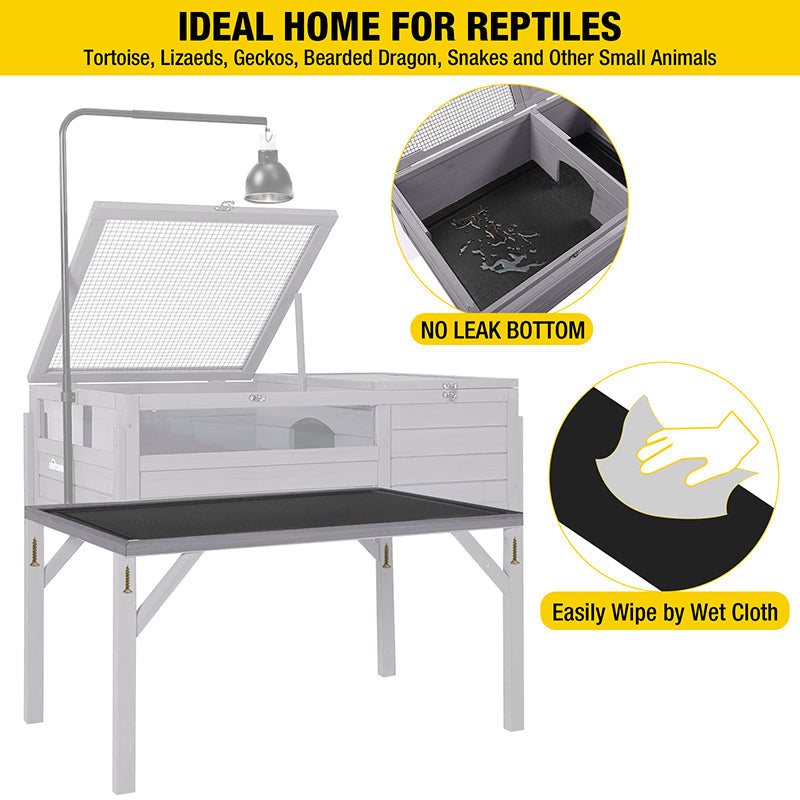Key Takeaways
Advanced climate control systems can replicate natural environments for reptiles, ensuring their health and comfort.
Automated feeders not only save time but also help regulate your reptile’s diet for optimum nutrition.
Habitat monitoring systems allow you to observe and adjust your reptile’s environment remotely, providing peace of mind.
Camera systems enable close observation of reptile behavior, fostering a deeper understanding and connection with your pet.
By integrating these high-tech solutions, you can create a thriving habitat for your reptile that’s both efficient and enjoyable.
As reptile enthusiasts, we always aim to provide the best care for our scaly friends. With the rise of technology, creating a high-tech habitat that closely mimics a reptile’s natural environment has become not just a possibility, but a game-changer in reptile care.
A Peek into the Future of Reptile Care
Imagine a world where your reptile’s habitat is controlled with precision, where the temperature, humidity, and even feeding schedules are all taken care of by smart systems. This isn’t a scene from a sci-fi movie; it’s the future of reptile care that’s available today.
“Aivituvin Large Turtle Habitat | Wooden …” from aivituvin.com and used with no modifications.
Creating the Ultimate Environment for Your Scaly Pals
Creating the perfect environment for your reptile isn’t just about comfort; it’s about their health. Reptiles are ectothermic, which means they rely on external sources to regulate their body temperature. Without the right heat and humidity, they can suffer from a range of health issues. That’s why climate control systems are so important.
Revolutionizing Reptile Habitats with Advanced Technology
With the latest advancements in technology, we can now provide a level of care that was once only dreamt of. High-tech reptile habitats are revolutionizing how we care for these amazing creatures, making it easier than ever to simulate their natural environment and meet their complex needs.
Climate Control Mastery
One of the most critical aspects of reptile care is maintaining the right climate within their habitat. This includes managing temperature and humidity to replicate the conditions they would experience in the wild.
Automated Temperature Regulation
Automated temperature regulation systems take the guesswork out of creating a comfortable environment for your reptile. These systems can be programmed to provide a gradient of temperatures throughout the habitat, mimicking the warmth of the sun and the coolness of the shade.
Set up a basking area with a heat lamp or ceramic heater that turns on and off at specific times.
Use a thermostat to maintain consistent temperatures throughout the day and night.
Ensure there’s a cooler area in the habitat for your reptile to retreat to if it gets too warm.
Managing Humidity Like a Pro
Humidity is just as crucial as temperature for reptiles, particularly for those species that come from tropical environments. Too much or too little humidity can lead to health problems such as respiratory infections or shedding issues.
High-tech habitats often include automated misting systems that release a fine spray of water to increase humidity levels at programmed intervals. This not only keeps the habitat at the right humidity level but also provides hydration for species that drink from water droplets.
Night and Day: Simulating Natural Environments
Reptiles need a cycle of day and night to regulate their circadian rhythms. Advanced lighting systems can simulate sunrise and sunset, providing your reptile with a naturalistic light cycle that promotes healthy behavioral patterns.
These systems can be programmed to gradually increase and decrease light intensity, which can help prevent stress in your reptile caused by sudden changes in lighting.
Choosing the Right Climate Control System for Your Reptile
When selecting a climate control system, it’s important to consider the specific needs of your reptile species. Some may require higher temperatures, while others may need cooler environments. Research your reptile’s natural habitat and replicate those conditions as closely as possible.
Most importantly, always have backup systems in place in case of technology failure. Your reptile’s life could depend on it.
Setting Up Your First Automated Feeder
Getting started with an automated feeder is a breeze, and it’s one of the best upgrades you can make for your reptile’s habitat. First, choose a feeder that’s compatible with your reptile’s diet—whether it’s pellets, live insects, or something else. Next, position the feeder in a stable location where your reptile feels comfortable eating. Then, simply fill the feeder with food, set the timer according to your pet’s feeding schedule, and let technology take care of the rest.
Scheduling Meals for Optimal Health
Consistency is key when it comes to feeding your reptile. An irregular feeding schedule can lead to stress and health issues. Automated feeders allow you to set specific times for meals, ensuring your reptile eats the right amount at the right time. This is especially important for species with strict dietary requirements.
Here’s how to get it right:
Determine how often your reptile species typically eats and at what times of day.
Program the feeder to dispense food according to this schedule.
Monitor your reptile’s eating habits and adjust the schedule as needed for their health and wellbeing.
Types of Automated Feeders: Pros and Cons
There are several types of automated feeders on the market, each with its own advantages and drawbacks. Gravity feeders are simple and reliable, but they don’t offer precise control over portion sizes. Electronic feeders provide more customization options and can handle a variety of food types, but they require regular maintenance to ensure they’re working properly.
When choosing an automated feeder, consider the following:
The type of food your reptile eats.
The size of your habitat and where the feeder will fit.
Your budget and the features you need.
Surveillance and Habitat Monitoring
Staying informed about the conditions inside your reptile’s habitat is crucial, and modern technology makes it easier than ever. Surveillance and monitoring systems can provide real-time data on temperature, humidity, and even your reptile’s activity levels. This information can help you make adjustments to ensure your pet’s environment is always optimal.
Plus, with remote monitoring capabilities, you can check in on your reptile from anywhere, at any time, giving you peace of mind when you’re away from home.
Keeping a Watchful Eye on Your Reptile
Cameras and monitoring systems not only let you observe your reptile’s behavior but also enable you to spot any potential issues early on. For example, if you notice your reptile is less active than usual, it could be a sign of a health problem or an issue with the habitat’s conditions.
Here’s how to set up your monitoring system:
Choose a camera that offers a clear view of the entire habitat.
Place sensors for temperature and humidity in various locations within the enclosure to get accurate readings.
Connect your system to your smartphone or computer for easy access to the data.
Essential Monitors for Every Reptile Enthusiast
When it comes to monitoring your reptile’s habitat, there are a few essential devices that every enthusiast should consider:
Thermometers and hygrometers to track temperature and humidity.
Timers and thermostats to automate heating and lighting schedules.
Cameras to observe your reptile’s behavior and habitat conditions.
Investing in these tools will not only help you provide better care for your reptile but also make the hobby more enjoyable and less stressful.
Integrating Cameras for Live Feeding Insights
Cameras can be particularly insightful during feeding times. By observing how your reptile hunts and eats, you can ensure they’re getting the right amount of food and behaving as expected. If you notice any changes in their feeding habits, you can quickly address potential health issues.
For example, if your normally voracious eater is suddenly disinterested in food, it could be a sign of stress, illness, or discomfort in their environment. With live footage, you can catch these changes early and take action.
Monitoring Your Habitat from Anywhere
The beauty of modern habitat monitoring is the ability to stay connected to your reptile’s environment from anywhere. Whether you’re at work, on vacation, or just out for the day, you can check in on your pet with a few taps on your smartphone.
Choose a monitoring system with a user-friendly app.
Set up alerts for significant changes in temperature or humidity.
Use the live video feed to check in on your reptile throughout the day.
With these capabilities, you’ll never have to worry about leaving your reptile alone again.
Say Cheese: Camera Systems in Reptile Habitats
Camera systems in reptile habitats are about more than just surveillance; they’re a window into the fascinating world of your pet. These systems allow you to capture moments you might otherwise miss and learn more about your reptile’s natural behaviors.
Watching your reptile interact with their environment can also be incredibly rewarding. It’s a chance to see the fruits of your labor as a caretaker and to appreciate the complex and beautiful creatures that reptiles are.
Installing Your First Habitat Camera
Installing a camera in your reptile’s habitat is a straightforward process. Choose a camera with night vision capabilities to observe your pet’s nocturnal activities. Make sure it’s placed where it won’t be obstructed by plants or decor, and where it won’t disturb your reptile. Secure the camera firmly to prevent any accidents, and then enjoy the live feed of your reptile’s day-to-day life.
Interacting with Your Reptile through Technology
Technology not only helps us care for our reptiles; it can also enhance our interaction with them. Some camera systems come with two-way audio, allowing you to communicate with your pet. While reptiles may not respond to voice commands like other pets, the sound of your voice can be comforting and help strengthen the bond between you and your reptile.
Remember, the goal of integrating high-tech solutions into your reptile’s habitat is to create a space where they can thrive. With the right tools and a little bit of tech-savvy, you can provide a top-notch environment that keeps your reptile happy, healthy, and ready for their close-up.
Interacting with Your Reptile through Technology
Embracing technology doesn’t just streamline reptile care—it enriches the interaction you have with your pet. Imagine using a camera system with two-way audio to talk to your reptile. While they may not understand your words, your presence can have a calming effect, and it’s a great way to check in on them during the day.
Furthermore, by observing your reptile through a camera, you can get to know their personality and habits. This insight can help you tailor their habitat and care routine to better suit their individual needs, ultimately leading to a happier, healthier reptile.
Analyzing Behavior Patterns with Visual Data
Camera systems do more than let you peek into your reptile’s world; they provide valuable visual data that can be used to analyze behavior patterns. For instance, if you notice your reptile is always basking under the heat lamp at certain times, you might adjust the lighting schedule to better suit their natural rhythm. To ensure the safety of your pet while adjusting their habitat, consider reading about dog-friendly adventure gear and safety, which can provide insights into creating a secure environment for your pet’s activities.
Behavioral changes can also signal health issues. If you see a decrease in activity or changes in feeding behavior, it’s a cue to take a closer look or consult a veterinarian. It’s all about creating a habitat that not only looks good but also supports the wellbeing of your reptile.
Sharing Your Reptile’s Life with the World
With today’s technology, sharing your reptile’s life with the world is easier than ever. Social media platforms and live-streaming services allow you to broadcast your pet’s daily activities, educate others about reptile care, and connect with a community of like-minded enthusiasts.
Whether it’s a rare moment of your snake shedding its skin or your lizard’s quirky feeding antics, these are the moments that can inspire others and perhaps even encourage responsible reptile ownership.
Frequently Asked Questions (FAQ)
Let’s address some common questions about integrating technology into reptile habitats, ensuring you have all the information you need to create the best possible environment for your pet.
How Does Technology Improve Reptile Habitats?
Technology enhances reptile habitats by automating routine tasks, such as temperature control and feeding, which helps maintain a consistent and ideal environment for your reptile. Automated systems also allow for precise monitoring and adjustments, which can improve the overall health and well-being of your pet.
Are Automated Systems Safe for All Reptiles?
Yes, automated systems are safe for all reptiles when used correctly. It’s important to choose equipment designed for reptile habitats and to follow the manufacturer’s instructions carefully. Regular checks and maintenance are also crucial to ensure the systems function properly and safely.
Can Cameras Stress Reptiles in Their Habitat?
Generally, cameras designed for reptile habitats are unobtrusive and should not stress your reptile. However, it’s important to place cameras in a way that doesn’t interfere with your reptile’s normal activities or invade their hiding spots, as this could cause them discomfort.
What’s the Best Way to Monitor the Habitat’s Climate Remotely?
The best way to monitor your reptile’s habitat climate remotely is through a smart monitoring system connected to an app on your smartphone or tablet. Look for systems that offer real-time alerts for temperature and humidity changes, so you can make adjustments as needed, even when you’re not at home.
Do Automated Feeders Handle Live Prey?
Some automated feeders are designed to handle live prey, but their effectiveness can vary based on the type of prey and the feeder’s mechanism. If live feeding is a crucial part of your reptile’s diet, look for a feeder specifically designed for this purpose and test it thoroughly to ensure it meets your reptile’s needs.
Research and choose the right equipment for your reptile’s species and habitat size.
Set up and test all technology thoroughly before relying on it for your reptile’s care.
Regularly maintain and check all systems to prevent malfunctions and ensure safety.
Use cameras and monitoring systems to deepen your understanding of your reptile’s behavior and needs.
Stay connected with your reptile’s habitat through smart devices to provide the best care, even when you’re away.
By incorporating these high-tech solutions into your reptile’s habitat, you’re not just simplifying your life as a pet owner; you’re actively contributing to a higher standard of care. Embrace the future of reptile care, and watch as your scaly companion thrives in their state-of-the-art habitat.






